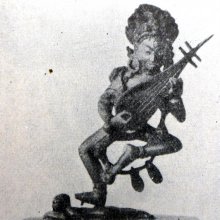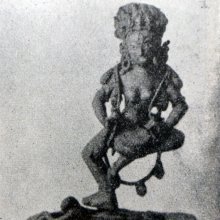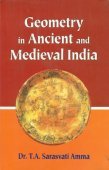Muraja, Murajā: 21 definitions
Introduction:
Muraja means something in Buddhism, Pali, Hinduism, Sanskrit, Jainism, Prakrit. If you want to know the exact meaning, history, etymology or English translation of this term then check out the descriptions on this page. Add your comment or reference to a book if you want to contribute to this summary article.
Images (photo gallery)
In Hinduism
Natyashastra (theatrics and dramaturgy)
Source: Wisdom Library: Nāṭya-śāstraMuraja (मुरज) refers to “drums” according to the Nāṭyaśāstra chapter 33. Accordingly, “Vajrekṣaṇa, Śaṅkukarṇa and Mahāgrāmaṇī are said to be gods of Murajas (drums). Mṛdaṅgas are so called because of being made of mṛt (earth), and they are called Bhāṇḍas because they bhramayati (move about). Murajas are so called because they are placed in an upright position (ūrdhvakaraṇa), and they are called Ātodya because of relating to todanā (striking).”.

Natyashastra (नाट्यशास्त्र, nāṭyaśāstra) refers to both the ancient Indian tradition (shastra) of performing arts, (natya—theatrics, drama, dance, music), as well as the name of a Sanskrit work dealing with these subjects. It also teaches the rules for composing Dramatic plays (nataka), construction and performance of Theater, and Poetic works (kavya).
Purana and Itihasa (epic history)
Source: archive.org: Nilamata Purana: a cultural and literary studyMuraja (मुरज) refers to a “musical instruments” (a sort of drum) that existed in ancient Kashmir (Kaśmīra) as mentioned in the Nīlamatapurāṇa.—The Nīlamata says that the land of Kaśmīra was thronged with ever-sportive and joyful people enjoying continuous festivities. Living amidst scenes of sylvan beauty they played, danced and sang to express their joys, to mitigate their pains, to please their gods and to appease their demons.

The Purana (पुराण, purāṇas) refers to Sanskrit literature preserving ancient India’s vast cultural history, including historical legends, religious ceremonies, various arts and sciences. The eighteen mahapuranas total over 400,000 shlokas (metrical couplets) and date to at least several centuries BCE.
Gitashastra (science of music)
Source: Shodhganga: Elements of Art and Architecture in the Trtiyakhanda of the Visnudharmottarapurana (gita)Murajā (मुरजा) refers to a “drum type of instrument”, according to the Viṣṇudharmottarapurāṇa, an ancient Sanskrit text which (being encyclopedic in nature) deals with a variety of cultural topics such as arts, architecture, music, grammar and astronomy.— In the Viṣṇudharmottarapurāṇa, the playing of murajā i.e., drum type of instrument is nicely explained. It is said here that to play these kinds of instruments, sixteen syllables are needed. These syllables are- ka, kha, ga, gha, ṭa, ṭha, ḍa, ḍha, ta, tha, da, dha, ya, ra, la and ha. These syllables are played on a drum kind of instruments with proper hand strokes.
Gitashastra (गीतशास्त्र, gītaśāstra) refers to the ancient Indian science of Music (gita or samgita), which is traditionally divided in Vocal music, Instrumental music and Dance (under the jurisdiction of music). The different elements and technical terms are explained in a wide range of (often Sanskrit) literature.
In Buddhism
Theravada (major branch of Buddhism)
Source: Pali Kanon: Pali Proper NamesAn inhabitant of Rammavati. He was a previous birth of Bodhi upatthayaka Thera. Ap.i.194.
Theravāda is a major branch of Buddhism having the the Pali canon (tipitaka) as their canonical literature, which includes the vinaya-pitaka (monastic rules), the sutta-pitaka (Buddhist sermons) and the abhidhamma-pitaka (philosophy and psychology).
Tibetan Buddhism (Vajrayana or tantric Buddhism)
Source: archive.org: The Indian Buddhist IconographyMurajā (मुरजा) refers to the “kettle-drum” and the deification thereof, as commonly depicted in Buddhist Iconography, and mentioned in the 11th-century Niṣpannayogāvalī of Mahāpaṇḍita Abhayākara.—Her Colour is smoky; her Symbol is the muraja instrument; she has two arms.
Murajā is described in the Niṣpannayogāvalī (vajraḍāka-maṇḍala) as follows:—
Source: academia.edu: The Structure and Meanings of the Heruka Maṇḍala“Murajā is of the colour of smoke, and she is engaged with her two hands in playing on the muraja instrument”.
[All these deities are collectively described as nude, violent in appearance, wearing garlands of skulls and severed heads and dancing in pratyālīḍha. They display the different instruments as their special symbols.]
Murajā (मुरजा) is the name of a Ḍākinī who, together with the Vīra (hero) named Muraja forms one of the 36 pairs situated in the Ākāśacakra, according to the 10th century Ḍākārṇava chapter 15. Accordingly, the ākāśacakra refers to one of the three divisions of the dharma-puṭa (‘dharma layer’), situated in the Herukamaṇḍala. The 36 pairs of Ḍākinīs [viz., Murajā] and Vīras are dark blue in color; they each have one face and four arms; they hold a skull bowl, a skull staff, a small drum, and a knife. Alternatively, the Ḍākinīs have their own marks and motions according to the taste instead of a small drum and a skull staff.
Note: Murajā is Murjī in Jayasena’s Ratnapadmarāganidhi (D 1516, 27 r 4)
Source: Brill: Śaivism and the Tantric Traditions (tantric Buddhism)Muraja (मुरज) refers to a kind of drum, according to the Bhūśalyasūtrapātananimittavidhi section of Jagaddarpaṇa’s Ācāryakriyāsamuccaya, a text within Tantric Buddhism dealing with construction manual for monasteries etc.—Accordingly, “[...] If a parasol, lotus, banner, muraja drum, flagpole, ornament, a woman of the court, fish, milk, the best curd, wine, blazing fire, and fruits [are seen], then there are victory, extraordinary increase of grain, property, [the number of] sons, and other [merits], and the completion of duties. [...]”.

Tibetan Buddhism includes schools such as Nyingma, Kadampa, Kagyu and Gelug. Their primary canon of literature is divided in two broad categories: The Kangyur, which consists of Buddha’s words, and the Tengyur, which includes commentaries from various sources. Esotericism and tantra techniques (vajrayāna) are collected indepently.
In Jainism
General definition (in Jainism)
Source: archive.org: TrisastisalakapurusacaritraMuraja (मुरज) is the same as Mṛdaṅga (a kind of drum), according to chapter 1.6 [ādīśvara-caritra] of Hemacandra’s 11th century Triṣaṣṭiśalākāpuruṣacaritra: an ancient Sanskrit epic poem narrating the history and legends of sixty-three illustrious persons in Jainism.—(cf. Abhidhānacintāmaṇi 2.207).
Accordingly, “[...] Sometimes, like Śakra, the King (i.e., Bharata) occupied the court of the amusement-hall to have a concert performed. The best flute-players blew the sweet-sounding flute, which has the first place in concert-work, like the oṅkāra among charms. [...] The mṛdaṅga-and paṇava-players played each his own instrument, never failing each other, like devoted friends [...]”.

Jainism is an Indian religion of Dharma whose doctrine revolves around harmlessness (ahimsa) towards every living being. The two major branches (Digambara and Svetambara) of Jainism stimulate self-control (or, shramana, ‘self-reliance’) and spiritual development through a path of peace for the soul to progess to the ultimate goal.
Languages of India and abroad
Pali-English dictionary
Source: BuddhaSasana: Concise Pali-English Dictionarymuraja : (m.) a tambourine.
Source: Sutta: The Pali Text Society's Pali-English DictionaryMuraja, (cp. Epic. & Class. Sk. muraja, Prk. murava: Pischel, Prk. Gr. § 254) 1. a small drum, tambourine J. V, 390; Vv 353 (=bheri VvA. 161); 8418 (=mudinga VvA. 340); SnA 370.—2. a kind of girdle Vin. II, 136. (Page 539)

Pali is the language of the Tipiṭaka, which is the sacred canon of Theravāda Buddhism and contains much of the Buddha’s speech. Closeley related to Sanskrit, both languages are used interchangeably between religions.
Sanskrit dictionary
Source: DDSA: The practical Sanskrit-English dictionaryMuraja (मुरज).—[murāt veṣṭanāt jāyate jan-ḍa]
1) A kind of drum or tabor; सानन्दं नन्दिहस्ताहतमुरजरव (sānandaṃ nandihastāhatamurajarava) &c. Mālatīmādhava (Bombay) 1.1; संगीताय प्रहतमुरजाः (saṃgītāya prahatamurajāḥ) Meghadūta 66,58; M.1.22; Kumārasambhava 6.4.
2) A stanza artificially arranged in the form of a drum; also called मुरजबन्ध (murajabandha), see K. P.9 ad loc.
Derivable forms: murajaḥ (मुरजः).
--- OR ---
Murajā (मुरजा).—
1) A large drum.
2) Name of Kubera's wife.
Source: Cologne Digital Sanskrit Dictionaries: Shabda-Sagara Sanskrit-English DictionaryMuraja (मुरज).—m.
(-jaḥ) 1. A small drum, a tabor. 2. A stanza the letters of which can be arranged in the form of a drum. f.
(-jā) 1. The wife of Kuvera. 2. A large drum. E. mura encircling, with wood, &c. ja born, made.
Source: Cologne Digital Sanskrit Dictionaries: Benfey Sanskrit-English DictionaryMuraja (मुरज).—I. m. A small drum, [Mālavikāgnimitra, (ed. Tullberg.)] [distich] 21. Ii. f. jā. 1. A large drum, [Kumārasaṃbhava, (ed. Stenzler.)] 6, 40. 2. The wife of Kuvera.
Source: Cologne Digital Sanskrit Dictionaries: Cappeller Sanskrit-English DictionaryMuraja (मुरज).—[masculine] a kind of drum or tambourine.
Source: Cologne Digital Sanskrit Dictionaries: Monier-Williams Sanskrit-English Dictionary1) Muraja (मुरज):—m. ([from] mura + ja?) a kind of, drum, tambourine (ifc. f(ā). ), [Mahābhārata; Kāvya literature] etc.
2) a Śloka artificially arranged in the form of a drum, [Sāhitya-darpaṇa] (also -bandha, [Kāvyaprakāśa])
3) Murajā (मुरजा):—[from muraja] f. a great drum, [cf. Lexicographers, esp. such as amarasiṃha, halāyudha, hemacandra, etc.]
4) [v.s. ...] Name of Kubera’s wife, [cf. Lexicographers, esp. such as amarasiṃha, halāyudha, hemacandra, etc.]
Source: Cologne Digital Sanskrit Dictionaries: Yates Sanskrit-English DictionaryMuraja (मुरज):—(jaḥ) 1. m. A small drum. f. (jā) A large one; wife of Kuvera.
Source: DDSA: Paia-sadda-mahannavo; a comprehensive Prakrit Hindi dictionary (S)Muraja (मुरज) in the Sanskrit language is related to the Prakrit words: Muraja, Muraya.
[Sanskrit to German]
Sanskrit, also spelled संस्कृतम् (saṃskṛtam), is an ancient language of India commonly seen as the grandmother of the Indo-European language family (even English!). Closely allied with Prakrit and Pali, Sanskrit is more exhaustive in both grammar and terms and has the most extensive collection of literature in the world, greatly surpassing its sister-languages Greek and Latin.
Prakrit-English dictionary
Source: DDSA: Paia-sadda-mahannavo; a comprehensive Prakrit Hindi dictionaryMuraja (मुरज) in the Prakrit language is related to the Sanskrit word: Muraja.
Muraja has the following synonyms: Muraya.
Prakrit is an ancient language closely associated with both Pali and Sanskrit. Jain literature is often composed in this language or sub-dialects, such as the Agamas and their commentaries which are written in Ardhamagadhi and Maharashtri Prakrit. The earliest extant texts can be dated to as early as the 4th century BCE although core portions might be older.
Kannada-English dictionary
Source: Alar: Kannada-English corpusMuraja (ಮುರಜ):—
1) [noun] a shallow, single-headed hand drum having jingling metal disks in the rim, played by shaking, hitting with the knuckles, etc.; a tambourine.
2) [noun] (rhet.) a type of construction of a verse in the form of a drum.
Kannada is a Dravidian language (as opposed to the Indo-European language family) mainly spoken in the southwestern region of India.
See also (Relevant definitions)
Starts with: Murajabamdaka, Murajabandha, Murajadhvani, Murajaka, Murajapa, Murajaphala.
Ends with: Maha-muraja, Prahatamuraja.
Full-text (+39): Maurajika, Murajaphala, Murajabandha, Muruja, Murajaka, Murava, Prahatamuraja, Bhanda, Samalekha, Murji, Muraya, Muracai, Murajadhvani, Muraje, Murajabamdaka, Maha-muraja, Atodya, Muracaketu, Nandikeshvara, Vajrekshana.
Relevant text
Search found 29 books and stories containing Muraja, Murajā; (plurals include: Murajas, Murajās). You can also click to the full overview containing English textual excerpts. Below are direct links for the most relevant articles:
Amarakoshodghatana of Kshirasvamin (study) (by A. Yamuna Devi)
Musical instruments (e.g., Stringed, Percussions, Cymbals and Wind-blown) < [Chapter 4 - Cultural Aspects]
Trishashti Shalaka Purusha Caritra (by Helen M. Johnson)
Part 16: The eight karmas < [Chapter III - The initiation and omniscience of Ajita]
Part 3: Citra and Sambhūta < [Chapter I - Brahmadattacaritra]
The Indian Buddhist Iconography (by Benoytosh Bhattachacharyya)
Manusmriti with the Commentary of Medhatithi (by Ganganatha Jha)
Verse 10.49 < [Section IV - Occupations of the Mixed Castes]
Vishnudharmottara Purana (Art and Architecture) (by Bhagyashree Sarma)
4. Instrumental Music (Vādya) < [Chapter 2 - Music]
3. A General Note on Art < [Chapter 1 - Introduction]
Sahitya-kaumudi by Baladeva Vidyabhushana (by Gaurapada Dāsa)
Text 9.37 [Citra-kāvya] < [Chapter 9 - Ornaments of Sound]
Text 9.44 [zig-zag diagram] < [Chapter 9 - Ornaments of Sound]
Related products


